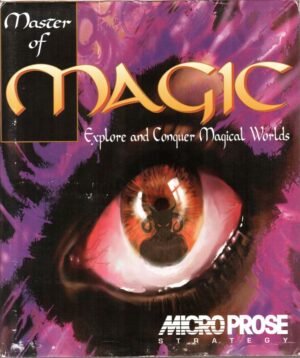Retro Replay Review
Gameplay
The Dark Half adopts a classic point-and-click adventure approach, immediately evoking memories of LucasArts’ SCUMM interface. Players guide Thad Beaumont through a series of static screens, collecting items, engaging in dialogue trees, and solving environmental puzzles. The cursor changes contextually to “look,” “talk,” “use,” and “take,” streamlining interaction and keeping the focus on exploration rather than on cumbersome controls.
(HEY YOU!! We hope you enjoy! We try not to run ads. So basically, this is a very expensive hobby running this site. Please consider joining us for updates, forums, and more. Network w/ us to make some cash or friends while retro gaming, and you can win some free retro games for posting. Okay, carry on 👍)
Puzzle design ranges from logical inventory combinations—such as using a typewriter ribbon to reveal hidden messages—to more obscure riddles that require thorough note-taking and keen observation. While some sections can feel obtuse, the game provides a generous hint system in the form of cryptic newspaper clippings and insider diary entries, ensuring that players never get completely stuck. Timing-based sequences, such as frantic escapes from your evil twin’s traps, inject variety into the otherwise leisurely investigative pace.
Dialogue plays a significant role in advancement, with branching options that can alter the flow of events subtly. Conversations with law enforcement, friends, and sinister figures unveil clues about both Thad’s innocence and the malevolent intentions of his dark counterpart. Although choices do not drastically change the ending, they enrich the narrative experience and reward replayability as you discover new layers of the crime-ridden world.
Graphics
The Dark Half opts for a hand-painted, 2D visual style that captures the eerie atmosphere of King’s novel. Backgrounds are rendered in muted colors—grays, browns, and deep reds—that convey an unsettling small-town setting. Character portraits display expressive animations, from Thad’s furrowed brow to the sinister grin of his evil twin, making each encounter memorable.
Transitions between locations are accompanied by subtle animations—drifting fog, flickering streetlamps, and moving shadows—that heighten tension without resorting to full-motion video. While not cutting-edge by today’s standards, these touches breathe life into static screens. A few textures can appear pixelated during close inspection, but the overall art direction remains strong and thematically consistent.
Cutscenes are interspersed sparingly, mostly to establish major plot beats: Thad’s dream sequences, gruesome crime scenes, and the climactic confrontation with the twin. These segments use pre-rendered sprites and simple fades, but they succeed in punctuating the narrative rhythm. The limited animation budget is apparent, yet the evocative set pieces and strategic use of sound ensure that graphical shortcomings never detract from the horror ambiance.
Story
True to its source material, The Dark Half follows Thad Beaumont, a once-renowned horror novelist whose alias, George Stark, has come to life and unleashed a reign of terror. What begins as a legal battle to prove Thad’s innocence quickly morphs into a nightmarish journey of self-discovery. Fans of Stephen King will appreciate the familiar motifs: duality, small-town secrets, and the fine line between creation and obsession.
Story pacing is deliberate, alternating between detective work—gathering witness statements, analyzing clues—and moments of genuine dread, as Stark’s crimes become increasingly gruesome. The narrative occasionally feels episodic, with each chapter focusing on a new victim or suspect, but the overarching thread remains compelling. Thad’s internal monologue, delivered through text that occasionally flashes on-screen like journal entries, deepens immersion and underscores his psychological struggle.
Supporting characters, from the unwavering Detective Hallett to the enigmatic Lawyer Westcott, offer both exposition and moral complexity. While some NPCs fit adventure-game archetypes, a handful deliver surprisingly nuanced dialogue that explores themes of guilt, identity, and redemption. The climax ties together loose ends effectively, leaving players with a satisfying conclusion that pays homage to King’s original twist.
Overall Experience
The Dark Half offers a richly detailed adaptation of Stephen King’s novel that will resonate with fans of horror and classic adventure games. Its measured pace allows for immersive investigation, while sporadic bursts of tension keep adrenaline levels high. The blend of inventory puzzles, dialogue choices, and timed escapes creates a varied gameplay loop that rarely feels repetitive.
While the graphics and animations may show their age, the hand-crafted art style and atmospheric audio design more than make up for any technical limitations. The soundscape—creaking floorboards, distant sirens, and Bernard Hermann–inspired musical cues—enhances the sense of dread, making late-night play sessions particularly spine-chilling.
Ultimately, The Dark Half is an evocative, well-paced adventure that successfully brings King’s dark narrative to interactive life. It may challenge newcomers unaccustomed to point-and-click conventions, but persistent players will find a rewarding story, memorable characters, and an experience that lingers long after the final scene. For anyone craving a moody, puzzle-driven horror escape, The Dark Half is a worthy addition to the genre.
 Retro Replay Retro Replay gaming reviews, news, emulation, geek stuff and more!
Retro Replay Retro Replay gaming reviews, news, emulation, geek stuff and more!









Reviews
There are no reviews yet.